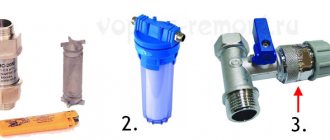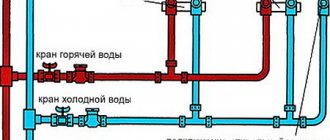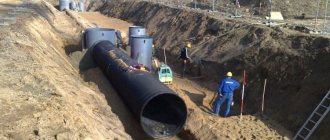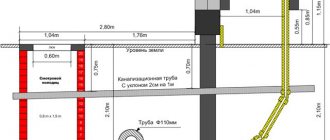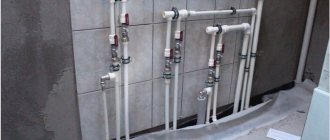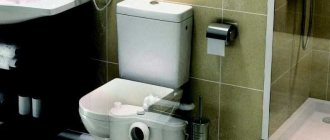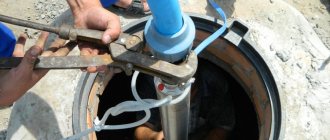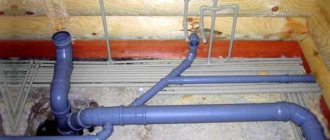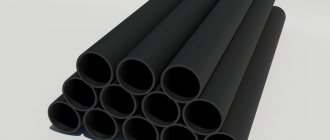The importance of proper design
- The water supply system in the apartment consists of central risers for cold and hot water supply and mains leading to water distribution installations. Additionally, liquid is drained to the flush tank on the toilet. The number of water distribution points depends on the layout of the apartment; in some rooms only cold water supply is used. In this case, a gas or electric heater is installed, from which the hot water supply line departs.
- The layout of the water supply pipes in the apartment provides for connecting a washing machine, which is installed in the bathroom, in the hallway or built into the kitchen unit. Some of the premises provide for the installation of a dishwasher, which is located in the kitchen (for example, under the countertop). If a shower cabin is to be installed in the bathroom, then it is necessary to install water pipes to the installation connection point.
- In 2-level residential premises or in apartments with increased space, several bathrooms can be used, and in the premises themselves, in addition to the toilet, a bidet or a small sink for washing hands can be installed. An increase in the number of distribution points complicates the water supply scheme for an apartment and increases the load on the main lines. Some devices require stable water pressure, so the reliability of the water supply depends on proper design of the system.
- For the manufacture of mains, polypropylene pipes are used, which are connected with straight and angular couplings. The material does not collapse under the influence of high temperatures and does not rust, which allows water pipelines to be used for 30-50 years without repair. The project must be drawn on the apartment plan, which will allow you to accurately determine the pipe exit points and calculate the amount of materials. At the same time, it is necessary to decide on the pipeline material, on which the range of couplings depends.
Decentralized source of water supply
Installation of water supply in a private house begins with any source that meets sanitary standards for water intake. Well, well, lake, river.
The most convenient and generally accepted option is a well, since in the event of a sudden power outage, and, consequently, the water pump, water can still be obtained manually. A well can play an additional decorative role on the site.
The second most popular is a system with a water well installed directly in the basement of the house. Thus, there is no need to dig trenches for pipes and the water pressure increases, since the pumping station does not need to pump water from afar, and the water supply can be installed directly into a private house.
The problem with this method is that the well can become silted and must be cleaned approximately once every 3-5 years.
The capabilities of different wells may differ in capacity, which depends on the saturation of the aquifer. The standard well width is about 10-15 cm, which allows the use of a submersible pump for water supply, but it is impossible to scoop water from the well.
Cunning homeowners usually supplement the well with a large water tank of 200-500 liters, which allows them to survive a power outage.
We do not consider artesian wells due to the great rarity of this type of source.
The construction of an artesian well is quite expensive, and permission to drill an artesian well is not very easy to obtain, since it will be necessary to justify the need to drill an artesian well.
Types of water supply pipes
The main types of pipes used in organizing water supply:
- Copper pipes connected using special solders. The lines are resistant to corrosion and can withstand heating up to 250°C. Pipes are elastic, which allows you to create pipelines of complex configurations. The disadvantage of the material is the formation of a galvanic couple upon contact with aluminum or steel elements. When used in multi-storey buildings, one should take into account the high current conductivity; if the neighbors’ equipment breaks down, the pipeline becomes energized.
- Metal-plastic pipes consisting of several layers of plastic with an aluminum gasket. The products are highly elastic; threaded bushings or crimp elements are used for connection. The products are not used for hidden installations, since the rubber seals at the joints lose their elasticity and allow water to pass through. The advantage is the absence of corrosion; the smooth internal surface prevents the formation of deposits.
- Products made of polybutylene that can withstand heating up to 90°C. The elements are connected using soldering technology, the seam is characterized by increased strength. Due to the high cost, polybutylene products are not widely used; the pipes are used in the construction of heated floors.
- Polyethylene reinforced pipes designed for pressure up to 3.5 atm. Use in water supply networks is not recommended, since the material is not highly durable. The parts are used for distributing water in personal plots or in domestic buildings; the material allows the liquid to freeze. When connecting, it is necessary to install a reducer that reduces the pressure of the water flow to a safe level.
- The lines are made of polyvinyl chloride, which is characterized by high chemical resistance and allows operation at temperatures up to 80°C. The disadvantage of the material is its low resistance to ultraviolet radiation. Soldering or glue is used to connect pipe fragments, but the strength of the joint does not allow water to be supplied under pressure above 3.5 atm. Pipes are used for water supply to technological premises or when organizing irrigation systems; a reducer is provided in the main line to reduce pressure.
- Pipes made of polyisopropylene, allowing elements to be connected by soldering. The material is low cost and allows pressure up to 12 atm. and temperature up to 130°C. The surface of the pipes is rough, but plaque does not form in the inside of the lines. The products are used for organizing risers and for distributing water inside residential or office premises.
When selecting pipes, you should take into account the cross-section of the internal channel, on which the throughput depends. To determine the parameter, it is necessary to find out the required pressure in the lines; the coefficient of pressure drop inside the pipe and at the joints is taken into account.
When planning the laying scheme, straight sections should be used, but excessive lengthening and cluttering the branch with reinforcement lead to a drop in pressure.
Which material to choose for input
There are several options for pipes for organizing water supply in the house, but the polypropylene pipe has proven itself well. The service life is designed for fifty years, it does not oxidize, withstands pressure loads, and is easy to install.
In terms of technical characteristics, such a pipe is inferior only to a copper pipe, but the price compensates for this disadvantage.
It is important to pay attention to the diameter of the input pipe. This determines how comfortable you will be when using your water supply system.
For input it is better to use a pipe with a diameter of 32 millimeters . It is slightly more expensive than a 25 mm pipe, but it will have a good supply of throughput, and this will play an important role in the future when the need arises to add consumption points. Also, it is better to install a pipe that can withstand a pressure of 10 atmospheres.
How to enter water
First you need to determine the place where you will bring the pipe into the house. Then you dig a trench from the house to the location of the water source. The depth of the trench directly depends on the area in which you live. The more the soil freezes during winter frosts, the deeper the trench should be. Sometimes, to make the trench depth smaller, the pipe is insulated. Each layer of such insulation reduces the depth of the trench by 20 centimeters.
How to connect to the central water supply was described above. Well, how to bring water into the house from a well? A pumping station, even the most powerful, may not always be enough. It all depends on the distance of the well from the house. a caisson is made not far from it and a pumping station is installed in it.
A suction pipe is lowered into the well at the level of the trench. Then the pipe is laid horizontally to the caisson, and there it is connected to the pumping station. Afterwards the pipe is laid to the house.
Unlike a well, drawing water from a well does not require making a caisson, since the well can be located both under the house building and outside it. But in any case, the hydraulic accumulator and everything else can be mounted either in the basement or next to the water inlet. A water supply pipe from a well can be routed in the same way as water is routed from a well.
In all cases, the polypropylene pipe should be covered with a small layer of sand before covering it with soil dug out of the trench. This will prevent damage to the pipe when backfilling with soil.
At the beginning of the work, it is necessary to make a diagram of the location of your communications throughout the territory.
After we have figured out how to bring water into the house , let's talk about what options there are for distributing water supply around the house.
Advantages and disadvantages of a combined and separate bathroom
Correctly organizing the distribution of pipes in an apartment from risers to consumers always means using hot and cold water in sufficient quantities.
Combined.
- It is assumed that all plumbing equipment is located in one room.
Separated.
- The wall (partition) zones the space into a toilet and a bathroom. It turns out two rooms for different needs.
The need for a combined bathroom arises due to the lack of space for installing a washing machine, bidet, furniture, etc. But such zoning is justified only if few people live in the apartment. While one is taking hygiene procedures, no one will be able to use the toilet.
People who have at least once been forced to install plumbing in an apartment with their own hands know that work begins with the creation of a project. Otherwise, the work turns into a series of trials and errors, which lead to loss of time and unnecessary losses.
Important! Most unnecessary costs can be avoided if you are consistent.
To hide pipes or not
It should be taken into account that the water supply distribution in apartments is initially open, and for good reason. When the design of a bathroom requires walling up a pipeline, it is necessary to take into account that not all pipes are designed for walling up.
Metal and metal-plastic fall under the category of materials that can be covered.
Regarding polypropylene pipes, you need to ask consultants when purchasing, since there are many types.
Important! Plastic cannot be embedded. Connections (fittings, couplings, etc.) must be freely accessible.
The main methods of installing water supply in an apartment
Piping in an apartment is carried out using 2 methods:
- sequential, performed using tees;
- beam or collector.
Each of the existing schemes for organizing the distribution of hot and cold water between consumers has its own advantages and disadvantages. Because of this, the technique is selected taking into account the design features of the apartment and the pressure in the central riser. In some rooms there are combined schemes that use collector and series wiring of highways.
Method 1: Series (Tee) wiring diagram
It is assumed that one pipe leaves the cold and hot water riser, which subsequently branches according to the number of consumers. The method is easy to implement, low-cost, and therefore popular. However, the pressure will jump if you turn on an additional plumbing fixture, which is inconvenient.
A sequential scheme for distributing water in an apartment is used for standard rooms in buildings built in the 60-80s. last century. The system includes central hot and cold water supply pipelines with an increased cross-section, to which outlets are connected.
The diameter of the main pipe must be larger than the size of the secondary channels, ensuring the supply of liquid at the required pressure and with the required volume to consumers. The lines are connected using tees, which is why plumbers often call the structure a tee.
Installation of water supply distribution in an apartment involves laying the main line through the premises in which consumers will be installed. Then, outlet channels are attached to the tees, which are led to the place where the mixer or geyser is attached inside the walls or partitions.
The advantage of the design is the reduced number of pipes, which reduces the cost of installing a centralized water supply inside the apartment.
a) The circuit is sequential (tee).
b) Beam (collector) circuit. In small apartments with a combined bathroom, a sequential circuit provides the necessary water pressure. But before performing installation work, it is necessary to carefully consider the location of the connecting elements, placing them under the sink, bathtub or in a special niche in the wall.
In this case, the procedure for repairing or connecting additional consumers is simplified. When using a sequential method, it is allowed to install the water supply in the apartment with your own hands (if you have the equipment and skills in soldering plastic pipes).
The main disadvantages of the scheme:
Installation of pipes in a sequential pattern is not suitable for elongated premises with a large number of consumers along the branch. As the disassembly point moves away from the central riser, the pressure in the system drops; the simultaneous activation of several water dispensing units further reduces the pressure at the end of the main. Due to this effect, incorrect operation of the equipment is observed (for example, the gas water heater does not ignite or operates intermittently).
If pipes or water distribution devices are damaged, the branch must be completely disconnected from the central riser. Installation of intermediate valves is allowed, but additional joints reduce the liquid pressure. The downside of the system is the large number of joints that are hidden deep in the wall or under decorative cladding. If a leak occurs, it will be necessary to dismantle the decorative coating over a long area, since it is impossible to accurately determine the location of the damage.
For example, installing a heated towel rail in a bathroom is connected to pipes hidden under a layer of tiles. To replace an element or current section of the pipeline, you will need to knock down the tiles. If the apartment owner still has a supply of tiles of the appropriate color, then the repairs will not require large expenses. But if there are no spare elements left, then it is necessary to completely change the tiles.
A toilet moved to another location may be useless if the drain pipe is not sufficiently sloped. A slope of at least 3 degrees is required so that waste water flows into the sewer by gravity. If it is not possible to make a proper drain, then there is only one way out - a pedestal for the toilet.
Method 2: Beam (collector) wiring option
Such distribution of water supply pipes in apartments of apartment buildings assumes that a separate pipe is supplied to each consumer. Due to the fact that on the way from the riser to the outlet of the pipeline the pressure is not cut off by additional connections, the pressure is always the same and sufficient.
The radial scheme for distributing water supply in an apartment is intended for rooms with an increased area or when installing a large number of plumbing equipment. The design includes an additional manifold, which is connected to the central riser.
The collector is equipped with couplings to which individual pipes are connected, laid to the installation points of water dispensing equipment. The circuit provides collectors for cold and hot water (with a different number of connection points).
Between the riser and the collector body there is a pipeline equipped with an emergency valve that shuts off the water supply to the room. It is possible to install taps with an electric power drive, which are activated by a signal from sensors on the floor covering. Sensing elements detect a leak and send a radio frequency signal, which is picked up by the controller. It is recommended to install a coarse filter in front of the collector, designed to catch sand and scale.
The advantage of the scheme is uniform pressure in the lines going to different consumers. The collector block is short and does not affect the drop in water pressure. Each outlet line is equipped with a valve that allows you to shut off the liquid supply during repairs or maintenance of the equipment. Installation of a water supply system using a collector circuit allows you to personalize the water supply parameters taking into account the technical characteristics of the device.
For example, in the line for switching a dishwasher, reducers are installed that reduce the pressure to the value recommended by the manufacturer. It is possible to install flow-through or storage filter units that allow you to separate mechanical impurities or regulate the degree of water mineralization. If there is insufficient pressure in the line, a pump is installed to increase the pressure (for example, to ensure the operation of a gas or electric heater).
The advantage of the collector circuit is the possibility of hidden installation of pipes in niches made in the walls . Pipes installed discreetly do not spoil the appearance of the room. If a leak appears in the line, the water supply is turned off. It should be taken into account that the design has a smaller number of connections, which further increases the reliability and durability of the pipeline.
The disadvantages of the scheme include:
To lay out water supply pipes using a radial scheme, a larger number of pipes are required (compared to a sequential scheme), which increases the cost of the design.
The use of additional elements (manifolds, valves) negatively affects the final cost of the system.
The switching circuit is highly complex, so creating a collector water distribution system in an apartment with your own hands is not recommended.
It is necessary to provide a distribution cabinet in which the manifold and valve blocks are mounted. If the room has hot water supply, then a second distribution block with valves is installed in the cabinet.
Method 3: Combined option
To install water supply pipes in an apartment with a branched layout, a combined scheme is used. A collector block is removed from the riser, to which the mains are connected. Then the branches are equipped with tees, which allows water to be supplied to several consumers.
The resulting circuit has all the disadvantages inherent in serial connection of equipment. But the technique allows you to reduce the cost of installation work, so the combined scheme is often used in individual residential buildings.
External piping
External water distribution pipes in a private house are installed after all construction work has been completed.
This is the most common scheme in private houses, when the water supply inlet is constructed after occupancy.
The external wiring system is comfortable, safe, allows you to control the water supply system at any stage and provides full access to all equipment. External wiring is easier to install than internal wiring and is more convenient. There are special clips, clamps and fasteners for pipes that allow you to perform installation work on external pipe routing as aesthetically pleasing and neat as possible.
It also makes sense to take a closer look at the design of mounting boxes, in which you can comfortably arrange pipes for external installation.
Server mounting boxes for laying fiberglass are perfect for covering pipes with a diameter of less than 4 cm. Ready-made mounting boxes are equipped with a snap-on plastic cover onto which you can stick a decorative strip of wallpaper or other material.
In the absence of ready-made mounting boxes, they can be easily built independently from ordinary wall panels.
How to make a diagram correctly
With properly configured wiring, water is distributed between the tap, shower, toilet cistern, bidet, washing machine, etc. In this case, each device receives a sufficient amount of liquid. The water distribution must be shown on the drawing. It also indicates the types of connections, installation methods, installation features, etc.
Before drawing up a wiring diagram, you need to decide on the materials from which the pipes will consist:
- Plastic;
- Metal-plastic;
- Copper;
- Steel.
When independently developing an apartment water supply scheme, you have to build on generally accepted norms and rules. It's better when specialists get down to business. In this case, in addition to graphical display, the document contains important information:
- list, labeling and quantity of all household plumbing products;
- information about pipe materials, diameter, length;
- the intended purpose of the pipeline and the direction of flow;
- list of necessary shut-off and control devices;
- location of protective and measuring instruments.
But this does not mean that the quality and information content of an apartment water supply diagram developed with your own hands will be lower. It all depends on attentiveness and accuracy.
What do plumbers call a point?
Plumbers use the term “point” when referring to the inlet or outlet of a plumbing fixture. When drawing up an estimate, it should specifically describe how much money it will cost to connect each point.
You need to understand that connecting a shower with hydromassage or Jacuzzi is much more difficult than connecting a regular sink or toilet. The “point” can be double if for its operation it is necessary to supply cold and hot water.
Workers are responsible for laying pipes, connecting and starting the system. Landscaping is not included in the standard range of services. The price of laying a pipeline also depends on the complexity of the work.
What will you need besides pipes and fittings?
An effective system cannot operate safely without:
- main valve of inlet shut-off valves;
- multi-stage purification filtration station;
- devices for adjusting and setting operating parameters;
- flow control instruments;
- devices for protection against the consequences of accidents;
- other additional equipment.
Each of these elements is necessary for the system to operate smoothly, be monitored, configured, and protected.
Main valve, inlet shut-off valves
This is a device that operates in two positions (open, closed). The task is to cut off the water supply from the riser if it is necessary to carry out repairs or in the event of a long absence of apartment residents. An alternative is valves that smoothly regulate water pressure and operate in an intermediate position. But such valves are more expensive than conventional ball valves.
Filtering devices
The minimum set consists of two types of filters:
Coarse cleaning
Installed at the inlet after the ball shut-off valve. The purpose of the filter is to catch large solid contaminants (rust, scale, etc.).
Fine cleaning
Absorbs small solid suspended particles. Special cartridges with fiber filler are used as filter elements.
Each filter requires periodic maintenance. During rough cleaning, the particles are retained by a metal mesh, which must be removed and washed. There are filter models equipped with a self-cleaning system. You have to buy new fine cleaning cartridges.
Regulating devices
The task of the stabilizing reducer is to maintain a comfortable pressure in the distribution pipes - this is from 3 to 4 bar. You can also use an electronic version - this is a pressure switch, which will eliminate the possibility of water hammer. A sharp surge in pressure can damage washing plumbing fixtures and wiring elements.
Check valves also fall into the category of control devices. They are needed if boilers are to be connected, and they protect the system from spontaneous drainage of water from the tank into the riser when the water supply is turned off.
Metering devices
The use of meter models is regulated by GOST. Installing it is not enough; flow metering devices must be calibrated and sealed. This is done by special water utility services. The device is equipped with a strainer and a check valve. When installing, there must be straight pipes on both sides. This will eliminate measurement error.
Emergency devices
This is a “smart electric valve” - this device protects the wiring from breaks and leaks, and the apartment from flooding. If a hose or pipe bursts, the pressure will drop sharply, and the device will immediately cut off the water supply.
Other auxiliary devices of sanitary cabinet
Properly organized plumbing in an apartment allows you to control operating parameters during operation of the water supply system. For this purpose, pressure gauges are used that measure the water pressure in the pipes. When there are several of them, the presence of a difference indicates a blockage that can be eliminated.
The manifold-distributor is a separate element that is involved in flow distribution. The number of outputs depends on the number of consumer devices. Ideally, each outgoing branch is equipped with a ball shut-off or check valve, depending on the need. Pressure gauges and emergency protection devices are also installed here.
Main components of the circuit
The water distribution diagram in a private house, or more precisely, the part of it that is responsible for supplying water to the house, consists of the following main components:
- pumping unit for a well or borehole,
- nipple (adapter),
- check valve preventing water backflow,
- pipeline,
- filter equipment (one or more different filters depending on water quality),
- shut-off valves,
- hydraulic accumulator,
- five-piece (fitting) for connecting the main elements and instruments (pressure gauge, pressure switch, pipes).
Elements of the water supply system of a country house with a well
What you need to know about collectors?
The collector block used in the installation of water supply systems is a piece of pipe with several side branches. The diameter of the input channel is 25-35% larger than the cross-section of the highways used for switching consumers.
This design ensures a uniform supply of liquid to several simultaneously switched on water taps while maintaining the required pressure. When selecting equipment, you should remember that there are manifolds for distributing cold and hot water.
To make the device body, brass or stainless steel is used; there are devices made of impact-resistant plastic that can withstand heating to temperatures of more than 100°C. Metal products are attached to pipelines using threaded bushings. To connect plastic pipelines, manifolds with compression transition elements or with special bushings (fittings) are used that allow plastic pipes to be soldered.
Manufacturers offer collector blocks with a clamp connection (Eurocone). The design of the unit uses a nut and a special split washer; rubber sealing rings are installed on the pipelines. Devices with a combined switching circuit are produced, allowing you to connect pipelines made of different materials.
When selecting a collector, you should take into account the number of outputs intended for switching external equipment. Standard products provide up to 6 channels, but manufacturers allow 2-3 collector modules to be connected in series. For coupling, couplings are provided at the nodes; the method of connection depends on the design features of the collector. If switching of the additional unit is not required, the collector is closed with an end cap.
Recommendations for the buyer
Basic recommendations for selecting a collector:
- Before purchasing a collector, you should decide on the type of material of the water pipes. It is recommended to use products made of polymers (for example, cross-linked polyethylene) that are not destroyed by water and do not have threaded connections.
- During the installation process, it is necessary to provide for the installation of a tap for the side lines. There are manifold blocks with integrated valves; the installer needs to connect the pipes and the manifold itself to the central riser. Please note that if the locking mechanism is damaged, the entire manifold block will need to be replaced. When using brass or stainless steel products, the taps must be installed separately.
- A block of additional devices is installed in front of the manifold (for example, meters, filters or a check valve).
How does the length of the water pipe affect the diameter of the pipes?
As for the length of communications, it is enough to know the following rules. If the length does not exceed 30 m, select pipes with a diameter of up to 20 mm; if exceeds, use products with diameters of 25 or 32 mm. In the latter case, the pipes can be used in conjunction with each other. It is allowed to use pipes less than 20 mm for a pipeline length of up to 10 m.
Why does the diameter of the pipes determine the throughput of the water supply system?
The throughput capacity of the system is fundamental when building a modern water supply. Today it is common to use plastic pipes. They do not clog, do not deform, and maintain internal smoothness for many years.
That is why, when talking about throughput, diameter indicators are always indirectly mentioned, since a larger diameter of the product provides greater throughput.
For example, metal corrodes and becomes clogged over time. Accordingly, the passage inside narrows, which means the output capacity decreases.
Particular attention is paid to the heating system built on the basis of plastic pipes. As a rule, these systems are closed, which implies the need to use uniform circulation.
It is worth remembering that if the cross-section of the pipes is doubled, the throughput will increase accordingly. This can lead to an increase in the heated volume of water and excessive consumption of boiler equipment power.
How is diameter designated and translation systems?
In modern water supply systems of private houses and apartments, both plastic and metal pipes are used. A plastic pipe, based on its diameter and wall thickness, is marked as D20 * 3.4. From this marking we understand that its outer diameter is 20 mm, while the wall thickness is 3.4 mm. To find out the internal diameter of the product, it is necessary to subtract the value obtained from 3.4 x 2 from the external diameter.
There are much more symbols in the marking of metal pipes. They can be reinforced, marked with the letter “U”, lightweight with the letter “L”, with a thread “P” and other options. The pipe marking must indicate the state standard, or technical standard. the conditions under which it was manufactured.
The calculation of the system, be it a plastic pipe or a metal one, is calculated from the nominal diameter. This indicator is called Du and is a universal value for water and gas metal pipes.
If we consider these values from the point of view of the value conversion system, then the values of Dу and D differ only in that the plastic pipe is smoother, therefore the amount of pressure loss in the pipes is less.
Before choosing the diameter of the pipe for the water supply, consult with specialists.
The information in the video will help you understand the pipe markings and choose the right diameter:
Common installation mistakes
Before distributing water in the walls of a room or in floor coverings, you should consider a thermal insulation scheme. The water passing through the pipes is cooled, giving off heat to the materials of the walls of the house and increasing the load on the autonomous heaters. Metal lines lacking an insulating layer are covered with a layer of condensation, which causes corrosion. Drops of water are absorbed into the wall material, causing mold or mildew to form.
During operation, plastic pipes expand. When laying highways in channels made in the walls, a reserve of space is provided. A padding polyester cover is placed on the outer part of the pipe. If the pipe is laid in a groove without a gap and covered with cement, then when heated, the surface of the wall cracks, which leads to shedding of the tiles or damage to the paintwork.
During installation work, it is necessary to cover the end edges of the pipes to protect them from foreign objects. Before soldering or welding, it is recommended to check the inside of the pipe for foreign objects. When dirt gets in, the water supply line becomes clogged or the water supply equipment gets clogged. To remove blockages, you will have to disassemble part of the water supply or repair taps or radiators of heating installations.
Soldering of plastic pipes is carried out using a special induction unit. Traces of dirt and oil are removed from the surface of the elements being connected, and water is not allowed to enter the joint. Foreign objects or liquid entering the weld joint will reduce the strength of the joint. If pipes are laid through the ceiling between floors, then individual holes are drilled in the slabs. It is not recommended to stretch pipelines in a bundle through a single channel, since the operating conditions of water mains deteriorate.
The design of the mains includes shut-off valves located in front of the water tap or at the outlet of the collector. The levers and wings of the valves should be located at a distance from each other, allowing for rotation.
When installing a water supply system, it is necessary to design sewer drains. The clean water supply and waste liquid drain lines should not overlap each other, making maintenance or repair work difficult.
